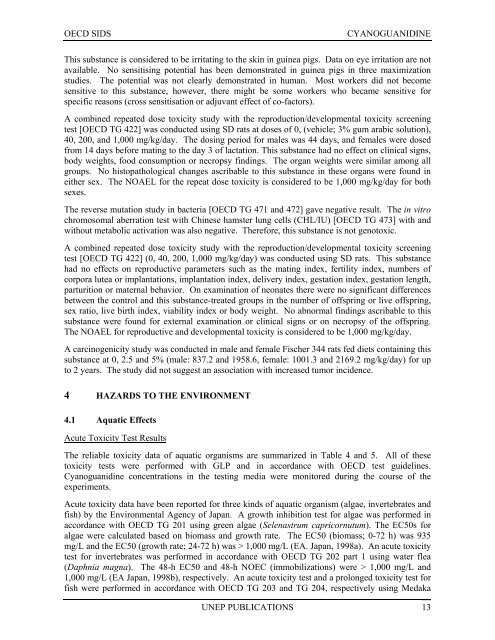Cyanoguanidine CAS N°: 461-58-5
Cyanoguanidine CAS N°: 461-58-5
Cyanoguanidine CAS N°: 461-58-5
Create successful ePaper yourself
Turn your PDF publications into a flip-book with our unique Google optimized e-Paper software.
OECD SIDS<br />
CYANOGUANIDINE<br />
This substance is considered to be irritating to the skin in guinea pigs. Data on eye irritation are not<br />
available. No sensitising potential has been demonstrated in guinea pigs in three maximization<br />
studies. The potential was not clearly demonstrated in human. Most workers did not become<br />
sensitive to this substance, however, there might be some workers who became sensitive for<br />
specific reasons (cross sensitisation or adjuvant effect of co-factors).<br />
A combined repeated dose toxicity study with the reproduction/developmental toxicity screening<br />
test [OECD TG 422] was conducted using SD rats at doses of 0, (vehicle; 3% gum arabic solution),<br />
40, 200, and 1,000 mg/kg/day. The dosing period for males was 44 days, and females were dosed<br />
from 14 days before mating to the day 3 of lactation. This substance had no effect on clinical signs,<br />
body weights, food consumption or necropsy findings. The organ weights were similar among all<br />
groups. No histopathological changes ascribable to this substance in these organs were found in<br />
either sex. The NOAEL for the repeat dose toxicity is considered to be 1,000 mg/kg/day for both<br />
sexes.<br />
The reverse mutation study in bacteria [OECD TG 471 and 472] gave negative result. The in vitro<br />
chromosomal aberration test with Chinese hamster lung cells (CHL/IU) [OECD TG 473] with and<br />
without metabolic activation was also negative. Therefore, this substance is not genotoxic.<br />
A combined repeated dose toxicity study with the reproduction/developmental toxicity screening<br />
test [OECD TG 422] (0, 40, 200, 1,000 mg/kg/day) was conducted using SD rats. This substance<br />
had no effects on reproductive parameters such as the mating index, fertility index, numbers of<br />
corpora lutea or implantations, implantation index, delivery index, gestation index, gestation length,<br />
parturition or maternal behavior. On examination of neonates there were no significant differences<br />
between the control and this substance-treated groups in the number of offspring or live offspring,<br />
sex ratio, live birth index, viability index or body weight. No abnormal findings ascribable to this<br />
substance were found for external examination or clinical signs or on necropsy of the offspring.<br />
The NOAEL for reproductive and developmental toxicity is considered to be 1,000 mg/kg/day.<br />
A carcinogenicity study was conducted in male and female Fischer 344 rats fed diets containing this<br />
substance at 0, 2.5 and 5% (male: 837.2 and 19<strong>58</strong>.6, female: 1001.3 and 2169.2 mg/kg/day) for up<br />
to 2 years. The study did not suggest an association with increased tumor incidence.<br />
4 HAZARDS TO THE ENVIRONMENT<br />
4.1 Aquatic Effects<br />
Acute Toxicity Test Results<br />
The reliable toxicity data of aquatic organisms are summarized in Table 4 and 5. All of these<br />
toxicity tests were performed with GLP and in accordance with OECD test guidelines.<br />
<strong>Cyanoguanidine</strong> concentrations in the testing media were monitored during the course of the<br />
experiments.<br />
Acute toxicity data have been reported for three kinds of aquatic organism (algae, invertebrates and<br />
fish) by the Environmental Agency of Japan. A growth inhibition test for algae was performed in<br />
accordance with OECD TG 201 using green algae (Selenastrum capricornutum). The EC50s for<br />
algae were calculated based on biomass and growth rate. The EC50 (biomass; 0-72 h) was 935<br />
mg/L and the EC50 (growth rate; 24-72 h) was > 1,000 mg/L (EA. Japan, 1998a). An acute toxicity<br />
test for invertebrates was performed in accordance with OECD TG 202 part 1 using water flea<br />
(Daphnia magna). The 48-h EC50 and 48-h NOEC (immobilizations) were > 1,000 mg/L and<br />
1,000 mg/L (EA Japan, 1998b), respectively. An acute toxicity test and a prolonged toxicity test for<br />
fish were performed in accordance with OECD TG 203 and TG 204, respectively using Medaka<br />
UNEP PUBLICATIONS 13
















